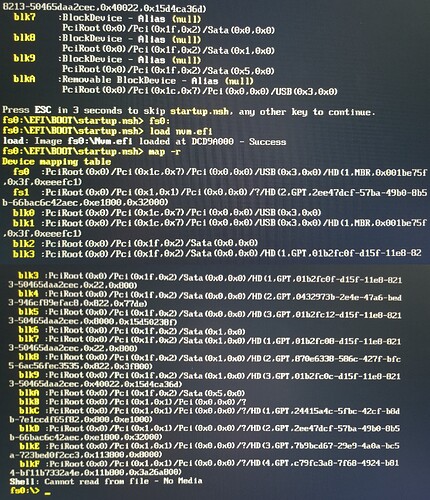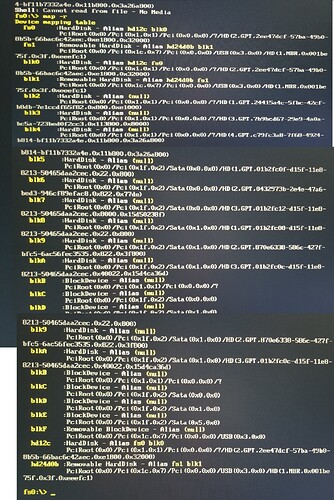Reviving an old topic, Because I use this today, and its working like a charm. I would like to include more information, for those in the future to use and maybe the OP can add it to the tutorial.
in addition, you can create a script, called startup.nsh
open in notepad.
copy and paste this
echo off
fs0:
load nvm.efi
shellx64
save and place inside folder efi/boot/ on your permanent usb bootdisk
when it loads the next shell
i made another startup.nsh using the “edit” command
and put in 2 lines
cd efi\boot
bootx64
so then i just type startup.nsh and windows loads!
Now my next question, maybe we can get some expertise. I’m looking for a way to boot the USB drive to the EFI shell without having to go into bios ![]() and having to type startup.nsh
and having to type startup.nsh
Move USB in boot priorities list in BIOS to first, before any HDD/SSD, would that possibly work to auto-boot the USB?
Since its the only bootable device in the boot list, it has the priority, when the computer loads, it just asks to remove all devices that do not have an operating system and insert a bootable device etc… so then i have to alt-ctrl-del and enter bios, and manually load the EFI
I have tried copying files from the windows 10 bootable usb key, however, it just loads up a boot menu to install win10 64b or win10 32b
basically need the boot file to load up the efi automatically, then the efi can automatically run the startup.nsh
thats half the problem
the second problem is having the actual windows 10 EFI shell to automatically load windows instead of having to manually type in "cd efi\boot" and "bootx64" to load windows!
another new issue was that my NVME went from taking 3 seconds to load to 23 seconds to load, and the keyboard/usb flashes repeatedly. I may have to do a "load optimized bios settings" and do a refresh on the windows 10 install if it doens’t auto fix itself.
i was thinking of installing a boot menu program, and seeing if there was a way to manually edit it to my needs.
Are you sure you’re looking at the hard drive boot list (not, first, second, third device order)? I assume if bootable USB, which it should be, it will boot right to it.
It does this on my end with a efishell Grub setup USB stick, just tested to confirm. UEFI USB device by name has to be set first in boot priority list, not just USB Device by name (Same device)
I have even tried force booting from the drive, it won’t boot from the usb, unless i manually specify to load efi from file system, the only other devices inside my PC are 2x 3TB seagates which have no operating system and are also in windows software raid 1. what is the contents of your bootable usb drive
mine has only 3 files
nvm.efi
shellx64.efi
efi\boot\startup.nsh
I know i’m missing something, and its probably stupid simple, and i’ve even read that you should just have a bootable usb drive with the shellx64.efi in the usb drive, is it suppose to be inside the efi\boot folder? I’ll play around with a few more times
Try putting also Shellx64 into EFI\Boot<br />
Mine works like that, but only with file named bootx64.efi (If it’s named shellx64.efi it does not boot, or boots to DOS on the USB if there)
Check your BIOS, when you hover or select the “Boot/Load to EFI” what does it say the filename it’s looking for? Name it to that, and put as mentioned above.
All boards differ on this, some look for bootx64, others shellx64, others possibly another name, BIOS usually tells you when you hove that option on the exit screen.
SO I did what you said, it worked!
but still having issues with the startup.nsh
However Thank you thank you thank you!
so now i have 4 files
shellx64.efi (which is probably not needed anymore)
nvm.efi
boot\efi\startup.nsh
boot\efi\bootx64.efi
before i was trying to put shellx64.efi into the boot\efi folder but nothing.
so here is my current startup.nsh file and i’m getting stuck at the map -r it loads so fast that the nvm doesn’t load before the map -r command is entered. the stall command isn’t working as i believe its stalling loading the driver. so we need another solution, maybe you can help me with this, it is relative to this forum post still.
fs0:
load nvm.efi
stall 5000000
map -r
cd efi\boot
bootx64
as it sits, when i press the power button, it boots into efi, loads the startup script, loads the nvm driver, and fails the map -r command. then i can manually enter map -r then startup.nsh 9 steps down to 2. so close 
Great and you’re welcome! Glad it didn’t end up only working on my end 
Does that exact command set work properly when running manually? What if you double or quadruple that stall time, same outcome? How about putting a double stall, or map twice?
I’m not sure how to make it wait longer, other than add more time and I’m not sure if there is a limit to that. Are you sure that’s the problem, it’s not loading driver fast enough before attempting to map?
After completing the failed script, you can immediately type map -r and it works. Here is my current test looks like, still no luck
fs0:
load nvm.efi
stall 3000000
stall 3000000
stall 3000000
stall 3000000
stall 3000000
stall 3000000
map -r
cd efi\boot
bootx64
Im sure somebody out there with some experience in the efi shell might know an easy work around. I also tried pause.
*edit. So i’ve come to theory, I think that the map -r command can not be ran in a script? because i manually ran the startup.nsh again and the map -r didn’t successfully load the nvm’s efi to load into windows?
Maybe, make end of script, call new script that has Map -r by itself? Or can your map -r be put into the startup.nsh? Or, can you somehow directly set the map location for the drive you want loaded?
Yeah I think if you referring to what I think then I have tried it a few days ago.
autoload startup.nsh
fs0:
load nvm.efi
fs:\1.nsf
new file called 1.nsf with
map -r
cd efi\boot
bootx64
I may end up exploring a boot loader option and closing the 30 second gap to 1-2 seconds or instant load off a boot loader option(s) Going to have a buddy help me, if hes not too busy. Hes pretty familiar with it.
Yes, I meant something like that, I’m not too good at this kind of thing, surely there is a way and a good answer! I bet the team over at stackoverflow can help! https://stackoverflow.com/questions
hey, I have a dubt…every time I have to insert usb with clover to boot win10 from m.2 nvmE or just the first time Have I to use clover (following that guide) and the next times win10 boot automatically from nvmE drive?
@toonamix - I have not used, but I believe you have to leave it in there or create a similar partition on your SSD (or another internal drive) and then correct things so it knows where the new location of the clover files is located,
@tele2 :
Since you had started 2 threads with a nearly identical title without pointing out the difference, I have merged them and hope, that this is ok for you.
If not, please send me a PM.
@z820man did you ever get to install Windows 10 on the NVME drive and be able to boot from it?
during the past few days I’ve been trying to get windows 10 installed on the newly acquired Samsung 970 Pro, unfortunately until now without success.
The 970 is sitting on this PCI-e adapter in the top PCIe3 x8 (4) — CPU0 slot of my HP Z820. I know OP has his NVME sitting in a different adapter in the lowest slot but the slot I chose to plug it in to should be fine right.
I have tried the DUET/REFIND method like our professor @DGroves suggested, there is actually also a 2019 version of it, however both didn’t work. I thought it was about to succeed, when I managed to boot into DUET and then get the Windows installer to start and I even could select the NVME drive as the medium to install on, where it not that after copying files the installation has to restart the computer to carry on. With the installer USB still plugged in, the installation just starts over, like in a loop. Without the USB Installer plugged in, there is nothing to select in de DUET boot manager.
I have tried the Clover method as well, to no avail.
Then I found this YouTube video but I got stuck at some point where I was left staring at a grub command line.
So I don’t know what I am doing wrong or missing (maybe missing certain files or whatever), I’m at a point where the amount of different things I’ve seen on the internet is overloading my head!
The whole purpose of buying the Samsung 970 Pro was to get Windows to boot from it, to gain speed over booting from a regular SSD, having it sitting there just as a storage medium wasn’t the plan.
Perhaps someone has an idea and / or willing to help me out (maybe even step by step through a chat platform if someone has time and willing to do so), that would be highly appreciated.
@tele2 you’re from the Netherlands right? I’m in Tilburg =)
Hello everyone and many thanks to Fernando and all the participants who help us.
In fact.
I have an old Asus Rampage Extreme 2 motherboard now. And I bought the Samsung 970 Pro 512 GB (a few days before I bought the Plextor M9Pe (Y) 256 GB and handed it back because I couldn’t make it a boot disk. At that moment I only found out about the existence of this resource. and tried to change the BIOS, but as it turned out to be impossible for me with this motherboard).
I studied three starting branches for a week
NVMe Support for old Systems
and eventually tried as recommended here.
The only thing I did was boot the USB method
HOW to MAKE THE USB flash drive (bootable) for DUET.
from this thread
[Guide] NVMe-boot for systems with legacy BIOS and older-UEFI (DUET-REFIND)
I copied to it Nvm.efi from here.
After that, I booted from it, went to the EFI shell and downloaded Nvm.efi. After a successful boot message, I typed exit and ended up on the start screen of the bootable USB. I went into the boot manager and chose to boot from the EFI CD drive.
Download and install Win 10 on SSD. After unpacking and installing the files and after rebooting, the EFI Win10 icon appeared in the startup window of the bootable USB. After pressing it, the installation continued with a successful end.
Thank you very much.
So now, the Win10 boot process from ssd is next. I boot from usb, choose EFI Win10 icon and continue.
So where did you put the windows 10 setup and what type of it iso file or extracted folder?

